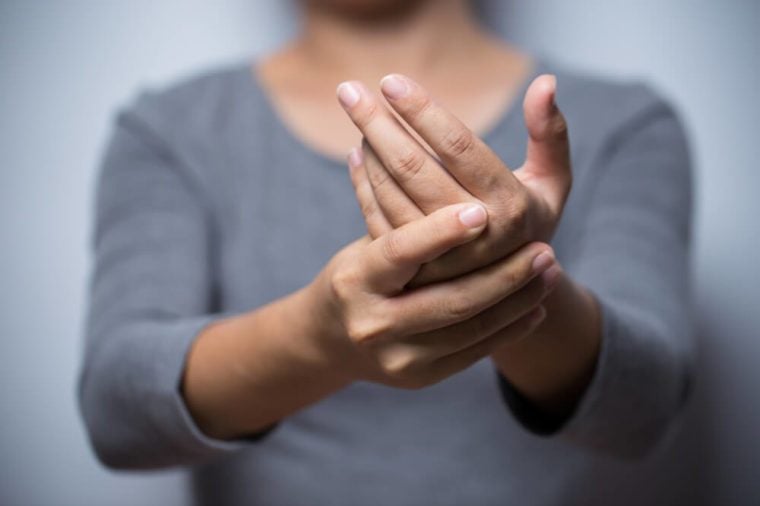CONDITIONS 14 Arthritis Symptoms You’re Probably Ignoring BY Elizabeth Manneh ( COURTECY; READER'S DIGEST )
- লিঙ্ক পান
- X
- ইমেল
- অন্যান্য অ্যাপ
CONDITIONS
14 Arthritis Symptoms You’re Probably Ignoring
Got a few annoying aches and pains? Maybe they’re just signs of age—or arthritis symptoms. Here’s how to tell.
The differences between rheumatoid and osteoarthritis
 ojoel/Shutterstock
ojoel/Shutterstock
Joint pain, swelling, stiffness, and grinding joints—they’re all classic arthritis symptoms. However, there are some silent early signs that masquerade as something insignificant, but in truth indicate the onset of arthritis. Do you know what to look for?
First, it’s important to understand the difference between the two main types of arthritis. Rheumatoid arthritis (RA) is a concern for all ages (here’s why millennials especially should be concerned about rheumatoid arthritis). This autoimmune disease triggers inflammation that attacks the joints, triggering swelling, tenderness, pain, and limited mobility. RA can also target organs.
Osteoarthritis (OA) has similar symptoms to RA like stiffness and joint pain, but it’s brought on by wear and tear on the joints. OA generally only develops later in life, and the symptoms are limited to the joints.
Rheumatologist Arundathi Jayatilleke MD, is an assistant professor in the division of Rheumatology at Drexel University College of Medicine, Philadelphia. We asked her to tell us which early signs of RA to watch out for.
Fatigue
 l i g h t p o e t/Shutterstock
l i g h t p o e t/Shutterstock
Fatigue is usually one of the first Rheumatoid arthritis symptoms. It can begin weeks or months before other symptoms appear, and is often accompanied by “not feeling right” or mild depression. “It’s just a general feeling of not having very much energy,” says Dr. Jayatilleke, “Like you might have had a virus or flu.” Sometimes this is just a reaction to the raised inflammation levels in your body, but occasionally it could indicate an underlying problem associated with RA. “Sometimes in RA you get anemia,” says Dr. Jayatilleke, “So that can contribute to the fatigue. It might be something picked up on in a blood test.”
Check out these other causes of fatigue, too.
Low-grade fever
 Helen Sushitskaya/Shutterstock
Helen Sushitskaya/Shutterstock
If you have a persistent low-grade fever, accompanied by some of the other early symptoms of RA, this might indicate the beginnings of the disease. “It’s usually not high or spiking fevers, but they’ll feel a little bit warm,” explains Dr. Jayatilleke. Unexplained fever, especially if it persists, is a reason to seek medical attention, she says.
Poor appetite and weight loss
 iko/Shutterstock
iko/Shutterstock
“Having uncontrolled inflammation can suppress your appetite,” Dr. Jayatilleke says. “Weight loss is usually not very drastic, but patients may notice that they don’t have quite the appetite for food and thus start losing weight.” And there’s another reason that early RA might result in losing some weight. Because the inflammation in your body increases your metabolic rate, you burn calories more easily. (Watch out for the foods that may contribute to RA inflammation.)
Dry eyes and mouth
 Rocketclips, Inc./Shutterstock
Rocketclips, Inc./Shutterstock
Problems with the eyes are a quite common side effect of RA, and the symptoms may show before the classic arthritis symptoms kick in. RA can cause the surface of the eye to become inflamed (episcleritis). Usually, it’s just a mild redness and irritation at first.
Another eye symptom of RA can be a reduced tear fluid—called Sjögren’s Syndrome. Dr Jayatilleke says that “people will notice that have a gritty sensation in the eye, or feel like there’s some dust stuck in it. They’re not producing as much tear fluid.” Your saliva production can decline as well as other body fluids.
Check out these other causes of red eyes and how to treat them.
Stiffness
 F8 studio/Shutterstock
F8 studio/Shutterstock
“Many people with RA experience morning stiffness: When they wake up in the morning they feel like they can’t move,” Dr. Jayatilleke says. “And some people don’t realize this is a sign of arthritis. They think this is part of growing old.” Lack of movement causes the joint to seize up; stiffness can also happen after napping or sitting,
Another of the early rheumatoid arthritis symptoms is stiffness in minor joints that isn’t caused by activity. Dr. Jayatilleke explains that this usually starts in the small joints, maybe in the hands or the wrists, and then progresses to the other joints. There may also be some mild joint inflammation. As well as consulting your doctor, you may find home remedies that help with RA. The stiffness can interfere with sleep, as well.
Painful chest
 igorstevanovic/Shutterstock
igorstevanovic/Shutterstock
One of the more surprising early rheumatoid arthritis symptoms is pain in the chest—although there are other conditions that can trigger chest pain—that aren’t a heart attack. Dr Jayatilleke explains: “Some RA patients get inflammation of the lining of the lungs, so it hurts when you take a deep breath.” she says. However, she points out that this is not a very common early sign. More usually it comes on after other symptoms.
Occasionally, the lining of the heart can get inflamed. Any unexplained chest pains can be serious—seek medical advice immediately if you’re experiencing them.
Classic symptoms
 CHAjAMP/Shutterstock
CHAjAMP/Shutterstock
Following the early symptoms, more classic rheumatoid arthritis symptoms will show themselves—though they might be the first ones to catch your attention. Swollen joints can put pressure on the nerves, causing numbness and tingling. Carpal tunnel syndrome is caused by pressure on the nerves in the wrist, and is commonly associated with RA. You may also notice cracking or squeaking noises when you move swollen joints.
Inflammation of the joints can also damage tendons and ligaments, reducing your range of movement. Eventually, you might find you can’t bend or straighten your limbs or back, although exercise and physical therapy can help. Here are some suggestions for beating back the pain of arthritis.
Osteoarthritis
 siam.pukkato/Shutterstock
siam.pukkato/Shutterstock
Because osteoarthritis is caused by wear and tear, the damage is localized to your joints. The early symptoms of OA are generally the more classic arthritis problems. Here’s how to protect your knees from unnecessary damage.
Grating sensation and bone spurs
 Soonthronphoto/Shutterstock
Soonthronphoto/Shutterstock
The spongy cartilage in your joints cushions bones as you bend, move, walk, and grasp things. As cartilage wears down, the bones can begin to grate and grind against each other, causing pain. Worn cartilage can also encourage the growth of bone spurs, potentially deforming joints.
- লিঙ্ক পান
- X
- ইমেল
- অন্যান্য অ্যাপ
মন্তব্যসমূহ
একটি মন্তব্য পোস্ট করুন